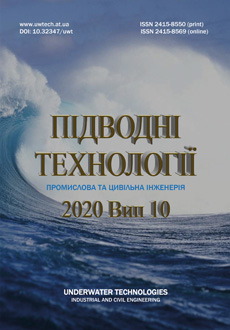Underwater radio device
DOI:
https://doi.org/10.32347/uwt2020.09.1501Ключові слова:
radio communication, antenna, electromagnetic wave, electromagnetic field, magnetic component, electromotive force, submarineАнотація
Creation of a radio communication device for underwater objects for the exchange of voice messages and for the transmission of digital data. The relevance of this problem is determined by the fact that the currently existing samples of equipment for underwater radio communications are excessively powerful, dimensional and with low bandwidth. An analysis of developments in this area showed that underwater radio communications can be organized on longitudinal electromagnetic waves or by using only the magnetic component of the electromagnetic wave.
The principle of operation of the device is based on the use of only the magnetic component of the electromagnetic wave. It is known that an electromagnetic wave consists of two components: electrical and magnetic. Water is an electrically conductive medium where the skin effect acts, according to which the deeper, the weaker the signal. But this is for the electrical component. Water has weak magnetic properties, so water is not a hindrance to the magnetic component of an electromagnetic wave.
Such a device, depending on its power, can be used both for individual communication of swimmers, and for the organization of radio communication between beacons and even for communication with submarines. It is possible to isolate the magnetic component of an electromagnetic wave according to two principles: to strengthen the magnetic component or to weaken the electrical component.
The separation of the magnetic component of the electromagnetic wave is carried out in the so-called magnetic antennas, which can be built in the form of coils with a ferrite core, can be of a frame type of a certain size or in the form of a coil in a screen made of non-magnetic metal. When upgrading conventional radio communication devices to the underwater version of their use, only the antenna-feeder path is subject to change, while other components of the communication channel remain unchanged. Application of such principles of radio communication organization will allow building submarine communication systems for an almost unlimited distance.
Посилання
Dolbnya, 2006. The history of the develop-ment of communications with submarines. Marine collection, No 5 (RUS).
V.I. Korobeinikov, 2020. The truth and fic-tion of EH antennas. Received from: https://www.qrz.ru/articles/article282.html (accessed date: 07.07.2020) (RUS).
Korochentsev V.I., Rublev V.P., Chayko A.V., 2003. Experimental studies of under-ground radio communications. Transactions of DVGTU, Iss.133, 5-8 (RUS).
Kulakov V.G., 2020. The problem of the radiation power of a magnetic antenna. Re-ceived from: http://newidea.kulichki.net/pubfiles/200423182640.pdf (accessed: 04/23/2020) (RUS).
Mobile radio complex wireless underwater communication IVA S/W, 2020. Received from: https://www.iva-tech.ru) (accessed June 7, 2020) (RUS).
Radio communication with submarines, 2015. Received from: https://argut.net/blog/
news-radiosvjaz-s-podvodnymi-lodkami.html (accessed October 16, 2015) (RUS).
Cisco AIR-ANT2547V-N-HZ= Antenna - 7 dBi, 2020. Received from: https://www.
amazon.co.uk/Cisco-AIR-ANT2547V-N-HZ-Antenna-Outdoor-Wireless/dp/B00X9ZL6C4 (date of the application 07.06.2020).
Ted Hart, 2003. EH antennas. ANTENTOP, No 2.
V.M. Simulik and I.Yu. Krivsky, 2011. Bosonic symmetries of the Dirac equation. Phys. Lett. A., Vol.375, No 25, 2479-2483.
Robert T. Hart, Vladymir I. Korbihikov, 2007. ANTENNA FOR ELECTRON SPIN RADATION. Patent United States No.: US 2007/0013595 A1 US 20070013595A1, Pub. Date: Jan. 18. 2007.
B. Bhattacharya and S. Mondal, 2013. Probability of Reception of Jovian Bursts as Derived from Io-Phase and the Location of Central Meridian Longitude. IJECT, Vol.04, 104-106.
B. Ismail and M. K. Hisham, 2010. Listen-ing to Jupiter's signal using Radio Telescope Recorder, ICCDA, Vol.01, 278-282.
B. Bhattacharya et al., 2012. Detection Of Jovian Radio Bursts At High Altitudes. IJEST, Vol.04, No 06, 3029-3038.
J. L. Lombardero, 2010. Radiotelescopio loop. CPAN-Ingenio, 1-16. Received from: https://www.i-cpan.es/concurso4/docs/
radiotelescopio-loop.pdf.
W. Kwon et al., 2013. A magnetic resonant loop antenna to enhance the operating dis-tance of 13.56 MHz RFID systems. ISOCC IEEE, 013- 014.
F. El Hatmi et al., 2011. Magnetic loop antenna for wireless capsule endoscopy in-side the human body operating at 315 MHz: Near field behavior. MMS IEEE, 81-87.
H. Martinez and M. R Ghezzi, 2014. La antenna cuadro o Magnetic loop. SOLVEGJ Comunicaciones, 1-13. Received from: http://lu6etj.hostargentina.com.ar/lu6etj/tecnicos/loop/antena_de_cuadro.htm.
N. K. Nikolova, 2014. Hamilton, Loop An-tennas. Received from: http://www.antentop.
org/004/files/tr004.pdf.
S. Yates, 2013. Small Transmitting Loop Antennas: Magnetic Loop Antennas. Texas, USA. Received from: http://www.aa5tb.com/loop.
html.
H. Rodrigues, 2015. Development of a Magnetic Loop Antenna for the Detection of Jovian Radiowaves at 20.1 MHz. Received from: http://www.scielo.org.co/pdf/tecci/v11n20/v11n20a06.pdf.
Bobrovsky I. V., 2013. Experimental studies of the acoustic communication system in shallow water. Acoustic magazine, No 59, Vol.06, 667-676.
Kirill Otradnov, Volodymyr Shuliak, Sergii Kornieiev, 2017. Underwater wire-less video communication in operations of AUV/UUVs – new horizon of underwater explorations. Underwater Technologies, Vol.06, 46-56.
##submission.downloads##
Опубліковано
Як цитувати
Номер
Розділ
Ліцензія

Ця робота ліцензується відповідно до Creative Commons Attribution 4.0 International License.
Автор(и) та Редакція згодні на те, що Редакція також матиме право:
- здійснювати необхідне оформлення Твору/Статті за результатами його редакційної обробки;
- визначати самостійно кількість видань, друк додаткових копій і тираж Твору/Статті, кількість копій окремих видань і додаткових тиражів;
- опублікування Твору/Статті в інших виданнях, пов’язаних з діяльністю Редакції

